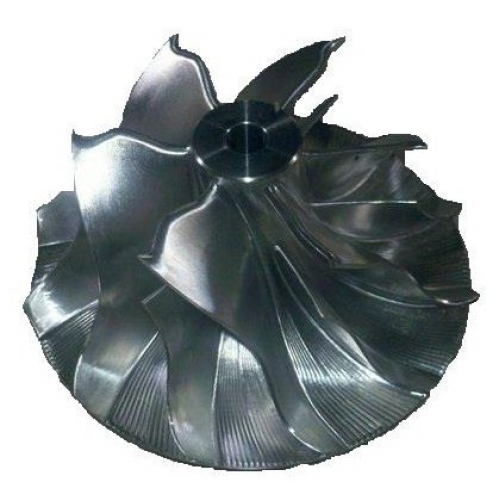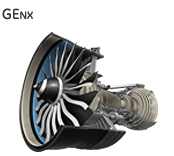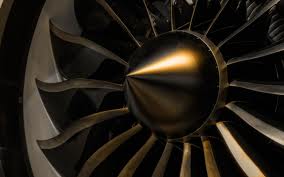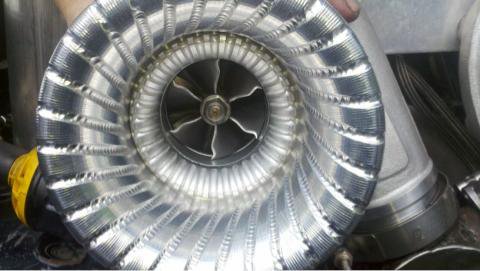| What's Hot! | Products/ Tools | EFI Tuning | Basic Tuning | Advanced Tuning | Chassis Tuning | Advertise with us |
Batmo Compressor Wheels for Turbochargers

An introductory look at new turbo technology coming to market
Contributed By: Enginebasics.com
A new compressor wheel design has just started to come to the market and is being called the “BATMO” wheel. This wheel has a very interesting design since its inducer compressor blade has a stepped lip to it. The justification to this is that this stepped lip allows the compressor blades to have more surface area and therefore provide more flow than another compressor blade of equal size inducer. (click for larger image)
This technology is not new technology but in-fact could be copied from what General Electric (GE) has recently done on turbine fan blades for jet aircrafts. While GE using the design in their jet engines, with probably a billion dollars invested into the technology seems to be a strong statement onto the overall blade design, there is still no concrete evidence if the "Batmowheel" has had the design work needed to make it work better then a standard wheel. That GE fan blade is the low-pressure stage that is 10' in diameter and used primarily for bypass air. How that transfers over to 5:1 pressure ratios of a 4" compressor is the real question.


When digging in deeper to the technology behind the GE design,, the GEnX blade is designed for a pressure ratio of 1.61:1. For turbochargers at least, high pressure blade design is considerably different then low pressure design. Five and Six blade compressors reduce the blade count to improve airflow at lower pressure ratios. If you want high-pressure ratio capability though, you step up to seven or eight blade wheels as the more blades, the more "grip" they can get on airflow at high pressure ratios. It's not an absolute requirement to have more blades, but that's definitely the trend. Also, it's an axial flow blade where a turbo compressor is a radial flow device.
This is still exciting news as it will be interesting to see as these style wheels come to market, if there is any concrete evidence that shows these compressor design produce more flow out of a given size compressor wheel. We here at enginebasics.com will do our best to keep you updated as this new technology comes to light.
ATTENTION READER:
If you enjoyed the information and article you just read be sure to check out our newly released book with even more exciting photo's and information:How to Turbocharge and Tune your Engine

Want to know more about your particular Make and Model vehicle? All of these vehicles are covered in the tech, maintenance and repair articles found above. Enginebasics is the wiki or wikipedia of car part, repair, how to and tuning information. Let us be the class 101 for your automotive learning.
| Ford | General Motors GM | Pontiac | Jaguar | Land Rover | Nissan |
| Toyota | Honda | Lexus | Acura | Lotus | Scion |
| Infinity | BMW | Mercedes | Mitsubishi | Ferrari | Maserati |
| Lamborghini | Volks Wagen VW | Saab | Audi | Hyundai | Kia |
| Subaru | Mazda | Chevy | Volvo | Caddilac | Dodge |
| Chrylser | Daewoo | Porsche | Mercury | Freightliner | MG |
Individual Models
| Ford Mustang | Mitsubishi Eclipse | Mitsubishi Evo | Subaru WRX / STI | Dodge Viper | Chevrolet Corvette |
| Nissan Skyline | Honda S2000 | Nissan 350z | Toyota Supra | Chevy Camaro | Lotus Elise Exige |
| Honda Civic | VW Golf | Dodge SRT-4 | Eagle Talon | Acura Integra | BMW M3 |
| Nissan 240sx | Porsche 911 | Acura NSX | Honda Accord | Toyota Camry | Toyota MR2 |
| VW R32 | Dodge Truck | Mazda Rx7 | VW Jetta | Sand Buggy | Nissan Sentra |
For the latest Automotive news and stories visit the websites below |
Our feature Build: An AWD V6 Civic





